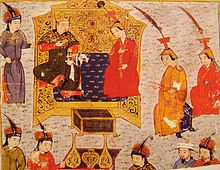| Sorghaghtani | |||||||||
|---|---|---|---|---|---|---|---|---|---|
 The Christian queen Sorghaghtani with her husband, Tolui. Rashid al-Din Hamadani, early 14th century. | |||||||||
| Born | c. 1190 Mongolian–Manchurian grassland | ||||||||
| Died | 1 March 1252[1][2] (aged around 62) Mongol Empire | ||||||||
| Burial | Gansu (at church) | ||||||||
| Spouse | Tolui | ||||||||
| Issue | Möngke Khan Kublai Khan Hulagu Khan Ariq Böke | ||||||||
| |||||||||
| House | Keraite | ||||||||
| Father | Jakha Gambhu, brother of Toghril | ||||||||
| Mother | Wasai | ||||||||
| Religion | Church of the East | ||||||||
Sorghaghtani Beki (Mongolian: Сорхагтани Бэхи/ ᠰᠤᠷᠬᠠᠭᠲᠠᠨᠢ
ᠪᠡᠬᠢ; Chinese: 唆魯禾帖尼) or Bekhi (Bek(h)i is a title), also written Sorkaktani, Sorkhokhtani, Sorkhogtani, Siyurkuktiti (c. 1190 – 1 March 1252[1][2]), posthumous name Empress Xianyi Zhuangsheng (Chinese: 顯懿莊聖皇后; pinyin: Xiǎnyì Zhuāngshèng Huánghòu and Persian: سرقویتی بیگی, Sorghoiti Bigi), was a Keraite princess and daughter-in-law of Genghis Khan. Married to Tolui, Genghis' youngest son, Sorghaghtani became one of the most powerful and competent people in the Mongol Empire. She made policy decisions at a pivotal moment that led to the transition of the Mongol Empire towards a more cosmopolitan and sophisticated style of administration. She raised her sons to be leaders and maneuvered the family politics so that all four of her sons, Möngke Khan, Hulagu Khan, Ariq Böke, and Kublai Khan, went on to inherit the legacy of their grandfather.
Given her enormous impact at such a critical point of the mighty Mongol Empire, she is likely one of the most influential and powerful women in history.[3] Sorghaghtani was a Christian, specifically a member of the Church of the East (often misleadingly referred to as "Nestorianism"). As a moving spirit behind the Mongol Empire, Sorghaghtani is responsible for much of the trade openings and intellectual exchange of the largest contiguous empire in world history.[4]
- ^ a b Hung Chin-fu (March 2008). "〈唐妃娘娘阿吉剌考〉" (PDF). 《中央研究院歷史語言研究所集刊》 (in Chinese). 79 (1). Republic of China: Institute of History and Philology, Academia Sinica: 41-62. Archived from the original (PDF) on 8 March 2023. Retrieved 8 March 2023.
拖雷忌日在九月,玉華宮影堂有祭;唐妃忌日在正月,玉華宮影堂亦有祭。《元史·文宗紀三》載,至順元年(1330)十二月「乙丑(十九日),遣集賢侍讀學士珠遘詣真定,以明年正月二十日祀睿宗及后于玉華宮之神御殿」睿宗皇后忌日為正月二十日,這是又一旁證。同書〈文宗紀四〉載,至順二年十二月「庚申(十九日),遣集賢直學士答失蠻詣真定玉華宮,祀睿宗及顯懿莊聖皇后神御殿」。如同至順元年那次一樣,這次也是十二月十九日決定人選,遣赴真定,估計祭祀日期應當也是一個月後的正月二十日。至順三年以後,玉華宮神御殿正月之祭可能有變。或者日期更動或者不再舉行。重紀至元三年(1337),羊歸建議「每年宜於正月二十日致祭」,真正原因,我們不清楚,但正月二十日為唐妃忌日,應當沒有問題。
- ^ a b Ke Shaomin. 《新元史‧卷六‧本紀第六‧憲宗》 (in Chinese). Republic of China.
二年春正月,帝幸失灰之地。命皇弟旭烈兀討木剌夷,以乃蠻人怯的不花爲前鋒。皇太后客烈亦氏崩。置經略司於汴。以忙哥、史天澤、楊惟中、趙壁等爲經略使,屯田唐、鄧諸州。
- ^ Jack Weatherford, Genghis Khan and the Making of the Modern World, The Secret History of the Mongol Queens. [ISBN missing]
- ^ Cite error: The named reference
weatherfordwas invoked but never defined (see the help page).